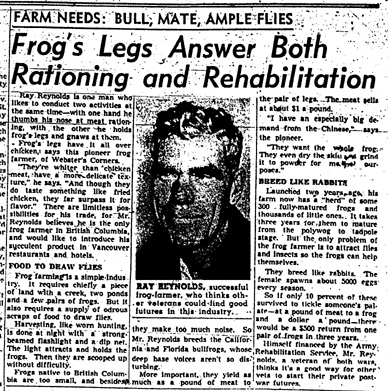 American Bullfrogs, and their closely related brethren, Green Frogs, were introduced to British Columbia as escapees from frog farms in the first half of the 20th century. In an attempt to kick start the economy, the Canadian federal government provided subsidies for veterans of the world wars to open up shop, hoping that the cheap and easily farmed delicacy would take hold in the Canadian diet. It never did, and in 1948, during one of the largest floods of the Fraser River, at least one farm was flattened, relieving thousands of frogs from their confinement, and forever changing the biotic landscape.
American Bullfrogs, and their closely related brethren, Green Frogs, were introduced to British Columbia as escapees from frog farms in the first half of the 20th century. In an attempt to kick start the economy, the Canadian federal government provided subsidies for veterans of the world wars to open up shop, hoping that the cheap and easily farmed delicacy would take hold in the Canadian diet. It never did, and in 1948, during one of the largest floods of the Fraser River, at least one farm was flattened, relieving thousands of frogs from their confinement, and forever changing the biotic landscape.
Bullfrogs can be voracious predators; they are the largest North American frog. Gobbling up anything that will fit in their mouths, they’ve been blamed for the decline of some bird and amphibian populations across the globe. Today in BC, Bullfrogs and Green Frogs are widely dispersed, and while Green Frogs have reached the edges of the Fraser Valley as it meets the steep Coastal and Cascade ranges, Bullfrogs are still slowly, but surely moving east. Beyond that front, lie the last vestigial populations of Oregon Spotted Frogs who’s demise has largely been the conversion of their habitat to farm, residential and commercial lands; and consequently, arrival of the Bullfrog could mean the final death knell for the species in Canada. The hopes are that by identifying habitats that Bullfrogs find suitable, we can properly plan the conservation of Oregon Spotted Frogs by targeting at risk areas for prevention.
In this paper, we present our efforts to systematically survey for the presence of Bullfrogs in an attempt to understand the landscape factors driving Bullfrog occupancy. Using this information, we then assess the suitability of habitat beyond the current invasion to understand which areas may need to be targeted for monitoring and prevention. While, being able to identify risk areas for invasion will help managers effectively allocate appropriate resources for prevention and monitoring, intense field surveys can preclude such programs. Conversely, using a modeling framework that is not appropriate for the species can yield meaningless results that will guide managers down the wrong path. Therefore, we also investigate the congruency of two methods of predicting invasive species range expansion: intense, resource consuming field surveys, or the much cheaper ecological niche model parameterized with publicly available online data.
That’s the teaser, now here’s the results: Murray et al. 2015 Predicting patchily-distributed species


